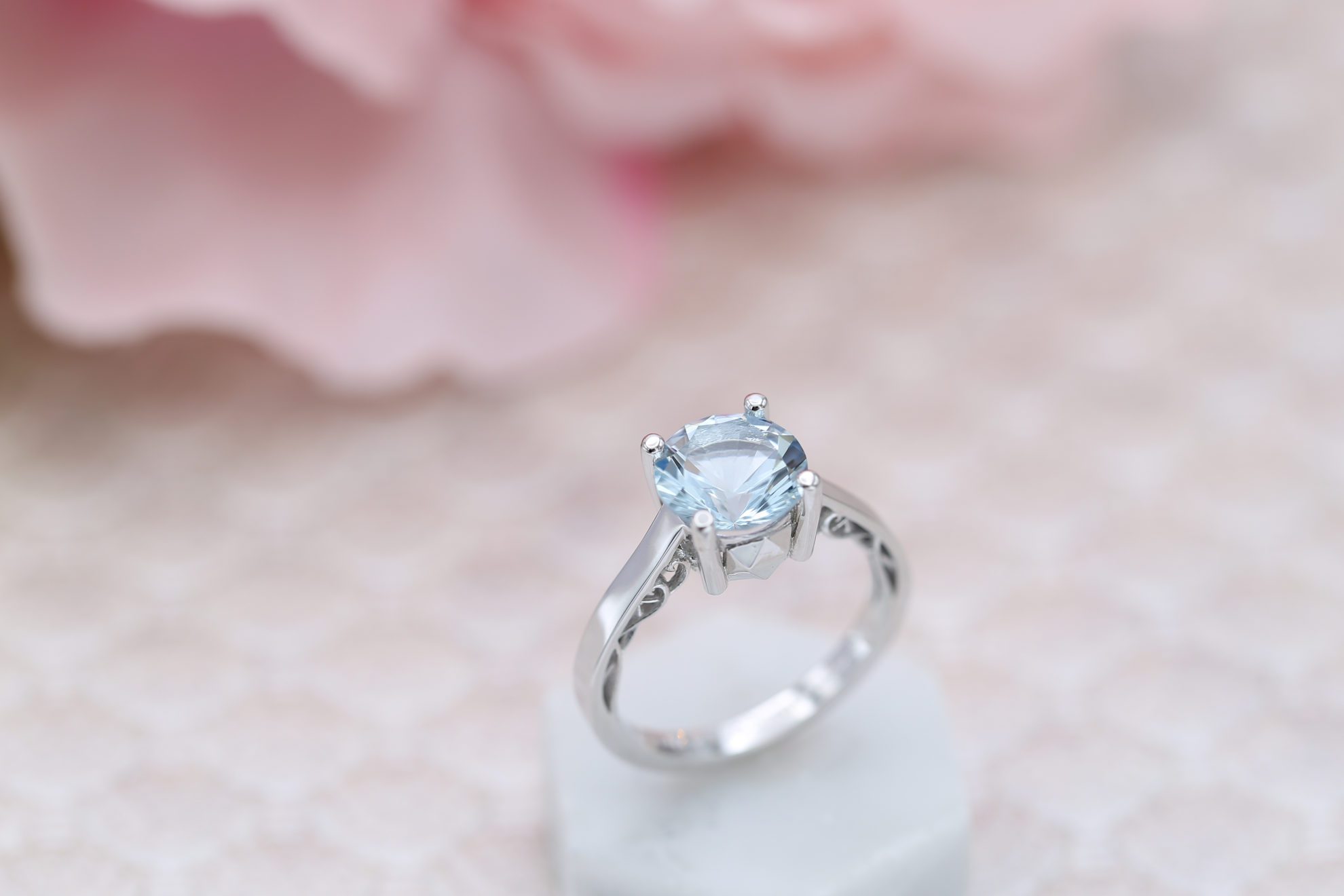Aquamarine Setting Advice
Aquamarines can look great, but what’s the best way to mount them? Novice jewelers should learn the pros and cons of various aquamarine setting options.
3 Minute Read
This white gold engagement ring features an oval aquamarine in a four-prong setting with a moissanite halo. The floral-style, open-back setting allows plenty of light to enter the aquamarine and then shine back though the table. (Note the stone's face-up brightness from 0:13 to 0:16). Video by CustomMade. Used with permission.
Interested in this topic?
This article is also a part of our Aquamarine Specialist Mini Course, in the unit How to Choose an Aquamarine.
Answer: Aquamarines have a wonderful, seawater-like color and, if cut properly, can produce beautiful reflections. Jewelers should keep those two features in mind when choosing an aquamarine setting.
Open-Back Settings
An open-back setting will hold an aquamarine in such a way that light will enter the stone from many angles. This will increase the gem's return of light, or brilliance, when viewed face up. Open-back settings include prong and some types of "invisible" settings.
Closed-Back Settings
In contrast, closed-back settings will block any light from entering the aquamarine through the pavilion. These mounting techniques, such as bezel, flush or "hammered," and channel settings, will give the stone a less sparkly appearance.
Metal Color and Aquamarine Setting
Aquamarines typically show a light blue color. Therefore, pay special attention to the type of metal used in the setting. Metals with a dominant color, such as yellow gold, brass, or bronze, can overwhelm a pale, lightly saturated gemstone. An aquamarine may appear colorless next to these metals. On the other hand, metals such as white gold, platinum, or silver will help highlight an aquamarine's light color.
Side Stones and Aquamarine Setting
Side stones present the same challenge as metal color to pale aquamarines. Usually, jewelers set aquamarines with colorless or pale gemstones. This will help lightly saturated gems look their best. The most common, classic combination is an aquamarine center stone with colorless or near-colorless diamonds for side stones. Some newer, bolder designs may pair aquamarines with gems such as morganites, which have pink color with a light tone.
Protective Settings for Aquamarines
Aquamarine has "Excellent" wearability. It has a hardness score of 7.5 to 8 on the Mohs scale, which means it's very resistant to scratches. This also means the gem is harder than the abrasives used for jewelry finishing, so it retains a good polish. Overall, aquamarines make very durable gemstones for jewelry designed for everyday use.
Nevertheless, aquamarines aren't indestructible. Most gemstones, including aquamarines, have a "Brittle" tenacity. That means they're prone to breaking if struck. Aquamarines also have imperfect cleavage. That means if they're struck along an internal cleavage plane they could split in two.
Generally, gemstones set in jewelry pieces such as earrings and pendants won't receive too much wear and tear, even if worn daily. However, ring stones have a greater chance of accidentally scratching or striking against hard surfaces. Aquamarine rings intended for daily wear should protect vulnerable areas of the gemstone.
Corners
Gemstone corners are vulnerable to breakage, especially in rings. To protect these areas in cuts such as pears and squares, jewelers use thicker prongs to completely envelope the corners. In cut-cornered designs, such as emerald or radiant cuts, some jewelers use eight prongs (instead of four) to protect all the pointed edges.
Girdles
Round and oval-shaped stones also have vulnerable areas, like girdles. Jewelers sometimes mount aquamarines in six or eight-prong ring settings to provide more protection for girdles.
A bezel setting will offer considerable protection, but as we've noted, it will reduce the gem's brightness. However, jewelers have other protective mounting options, like tension settings, which still offer protection while allowing more light to enter the stone.
18k white gold ring with a 4-ct, emerald-cut aquamarine in a tension setting. Photo courtesy of liveauctioneers.com and Auctionata Paddle 8 AG.
Multiple-Stone Settings
When mounting an aquamarine together with gems of different hardness, keep in mind that any contact between the stones may result in scratches. If set against a gem with higher hardness, like a diamond or sapphire, the aquamarine will start showing wear. If set against a gem with lower hardness, like an opal or hessonite garnet, the other stone will start showing wear. Therefore, make sure any such combinations are mounted in a way that keeps the stones separate and secure.
International Gem Society
Related Articles
Aquamarine Value, Price, and Jewelry Information
Trapiche Gems: An Introduction
Aquamarine Enhancements
Distinguishing Aquamarine Imitations
Latest Articles
800 Years of Mogok: A Celebration in Tenuous Times
What is the Average Gemstone Faceting Yield?
Pyroxmangite Value, Price, and Jewelry Information
How to Identify Emerald Simulants and Synthetics
Never Stop Learning
When you join the IGS community, you get trusted diamond & gemstone information when you need it.
Get Gemology Insights
Get started with the International Gem Society’s free guide to gemstone identification. Join our weekly newsletter & get a free copy of the Gem ID Checklist!
